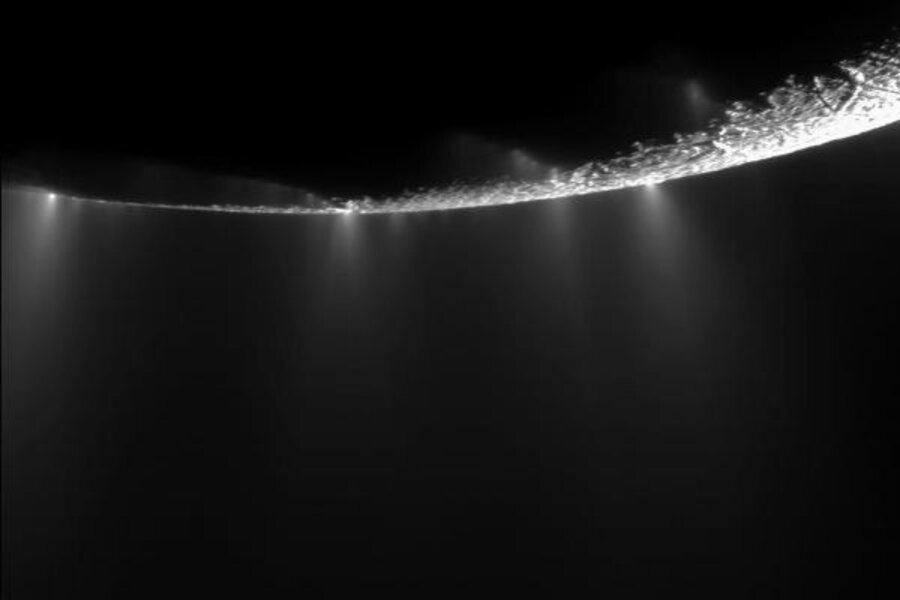Hidden sea on a Saturn moon? New evidence says yes.
Loading...
Spectacular geysers of ice crystals that erupt from Saturn's moon Enceladus – and that formed Saturn's diaphanous E-ring – likely come from a subsurface sea reminiscent of Jules Verne's "Journey to the Center of the Earth."
Moreover, the geysers appear to be driven by a mysterious heat source unlike anything yet seen in the solar system.
Those are the implications of a new study of the geysers' plumes. The study will appear in Thursday's issue of the journal Nature.
If the conclusions hold up to further scrutiny, they also imply that ice-encrusted Enceladus – far from the sun's "habitable zone" – could harbor a subsurface environment hospitable to simple forms of life.
Although the notion of a under-ice sea on Enceladus isn't new, until now the evidence in hand has allowed for an explanation for the ice plumes that doesn't require presence of liquid water, explains Sascha Kempf, a planetary scientist at the University of Colorado at Boulder and a member of the team reporting the results.
But by analyzing ice samples from the plumes, gathered by NASA's Cassini orbiter, the research team determined that 99 percent of the mass of the plumes is accounted for by salt-rich ices.
The simplest way to pick up the salts is for water to leach them out of rock over long periods of time. It's a process similar to the one that salts Earth's oceans.
The new results indicate that, despite its sound basis in physics, the "dry" solution to the geyser puzzle "is now off the table," Dr. Kempf says. "Nature did not choose that option."
The results conjure up an image of a sea in a vast subsurface cavern, Kempf acknowledges, although he adds that the team doesn't know whether the sea is global or local to the south pole.
According to the model proposed by the research team, water boils off the top of the subsurface sea, into the near-vacuum environment. As the water bubbles burst, the spray freezes into tiny crystals that get swept along with gases, up through fissures in the moon's ice crust.
The new results resonate with at least one scientist who help craft the "dry" explanation for the plumes, which appeared in a 2006 research paper in the journal Science. "I prefer this straightforward explanation," offers John Spencer, a planetary scientist at the Southwest Research Institute in Boulder, Colo. "The warm temperatures implied by liquid water will provide plenty of pressure to drive the plumes," he writes in an email exchange.
If this explanation is correct, it suggests that the moon provides an environment suitable for at least simple forms of life to emerge. Liquid water would imply an energy source, while water itself is seen as a necessary ingredient for organic life.
Questions of life aside, Enceladus is one of only four objects in the solar system currently displaying active volcanism, or in the case of chilly objects, cryovolcanism. The others are Earth, Jupiter's moon Io, and Neptune's moon Triton.
On Enceladus, southern geysers erupt along ice fissures in a region scientists have dubbed the "tiger stripes."
Over the course of Cassini's many flybys, the geysers' output has remained essentially constant over time, according to Kempf – an observation he calls "really stunning" and also at odds with what one would expect from the "dry" explanation for the plumes.
It takes a large, steady delivery of energy to maintain that constancy, he explains. And it takes a large amount of energy to maintain a subsurface liquid reservoir.
Indeed, the amount of energy needed exceeds estimates of the heat available from two oft-cited sources: radioactive decay of rocks in the core, and heating by friction from the gravitational tugs of Saturn and its other moons.
At the moment, no one seems to have a reasonable working hypothesis for the mechanism providing the energy, although scientists are working on it, he adds. The challenge is two-fold: A plausible explanation not only has to explain the current source, but also how it evolved over the moon's history.
The plumes themselves were discovered in 2005, when NASA's Cassini spacecraft, currently orbiting Saturn and its moons, made several close fly-bys of Enceladus.
The plumes feed Saturn's E-ring, its outermost ring, which was discovered in 1967.
Analysis of the ring's crystals revealed a surprise. Although the ring is dominated by salt-poor ice, some ice is heavily salted. This fueled speculation that the geysers rise from subsurface water in contact with the moon's rocky core. That core would have been the source of the salts.
This new study involves the analysis of particles taken directly from the moon's plumes during additional fly-bys. The observations, along with modeling studies the team performed, indicate that the ring holds more salt-poor crystals than the plumes themselves because the salt-rich crystals are heavier, and fall back to Enceladus's surface.
To test this model, scientists would like to look for a salt-enriched surface near the geysers, but unfortunately, Cassini's instruments aren't sensitive enough to detect that level of surface enrichment, Kempf says.
The team reporting these latest results was led by Frank Postberg, a researcher at the University of Heidelberg in Germany.





